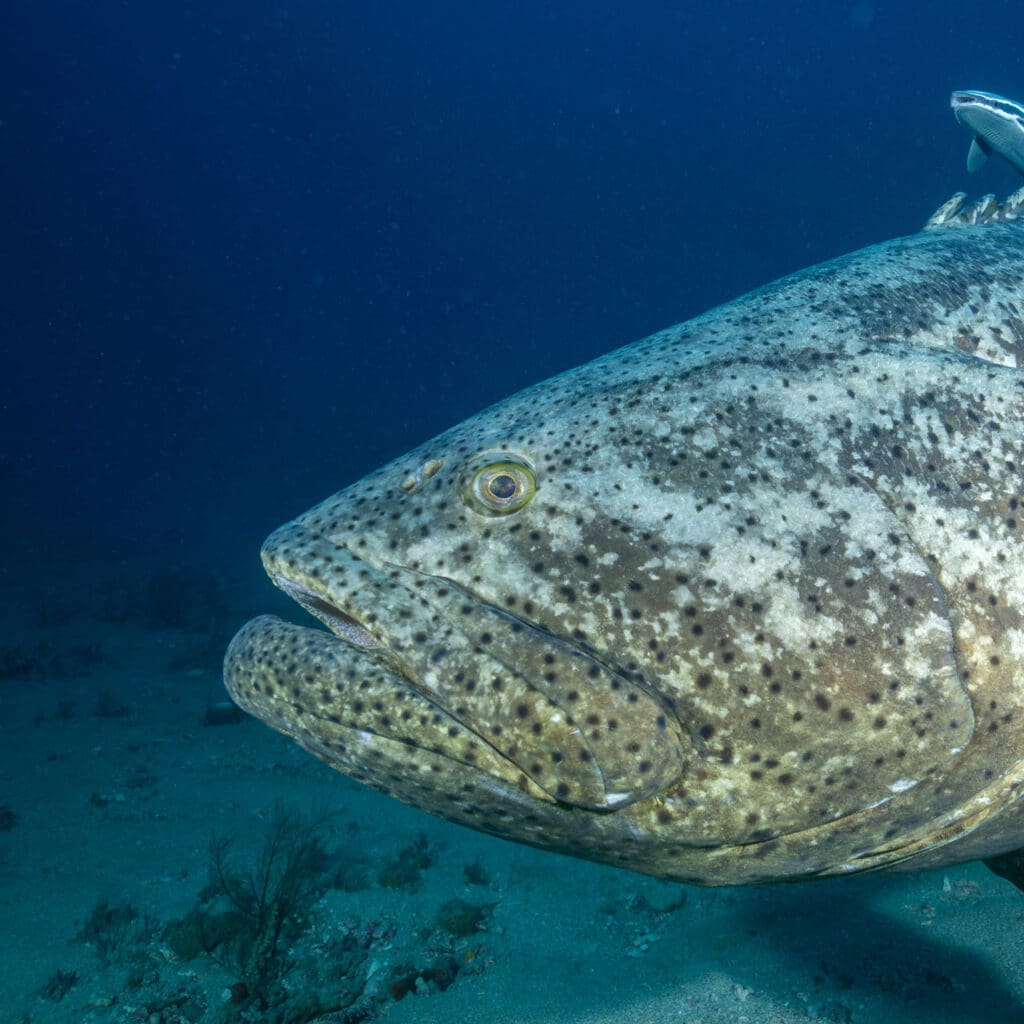Welcome back to another episode of #fff or Friday Fish Facts!
The Goliath Grouper (Epinephelus itajara), is one of the most fascinating and formidable fish inhabiting the Atlantic Ocean. Known for its massive size and distinctive appearance, this species has a significant presence in the waters off South Florida. Broward County, with its extensive coral reefs and artificial wrecks, provides an ideal habitat for these giants. These areas offer abundant shelter and food sources, making them prime locations for Goliath Groupers to thrive.
Habits and Diet
Goliath Groupers are known for their solitary and territorial nature. They prefer to inhabit shallow tropical waters, often around coral reefs, mangroves, and shipwrecks. These environments provide the necessary cover and hunting grounds for their ambush predation style. Goliath Groupers are opportunistic feeders, preying on a variety of marine life including fish, crustaceans, and even small sharks.
Out Scuba’s own Andre Saade ran into one last weekend on the Wreck of the Ancient Mariner. He said the huge fish was hiding in the darkness inside the bow and could not be enticed to come out. Unfortunately, his video was too dark to make anything out, but the feeling of having one of these behemoths eye you from the dark is something you don’t ever forget.
Their diet primarily consists of slow-moving species, which they capture using their large mouths to create a powerful suction. This feeding method allows them to swallow prey whole. The Goliath Grouper’s ability to consume a wide range of prey contributes to their role as apex predators in their ecosystem, helping to maintain the balance of marine life.
Spawning Behavior
The spawning behavior of Goliath Groupers is both fascinating and critical to their survival. These fish reach sexual maturity around the age of six to seven years. Spawning typically occurs during the summer months, from July to September, when water temperatures are warmest. During this period, Goliath Groupers gather in large aggregations at specific spawning sites, often around shipwrecks and reefs.
These spawning aggregations are vital for the species’ reproduction, as they increase the chances of successful fertilization. The females release their eggs into the water column, where they are fertilized by the males. The fertilized eggs then drift with the currents until they hatch into larvae. The larvae eventually settle in shallow, protected areas such as mangroves, where they grow and develop before moving to deeper waters.
Best Places to See Goliath Groupers
For Out Scuba members interested in observing Goliath Groupers in their natural habitat, several locations in Florida offer excellent opportunities. The waters off Broward County, particularly around the coral reefs and shipwrecks, are prime spots for encountering these giants. Other notable locations include any type of wreck or reef structure from Jupiter down to the Florida Keys.
Diving enthusiasts often flock to sites like the wreck of the USS Spiegel Grove in Key Largo and the reefs around Jupiter and Palm Beach. These areas are known for their high visibility and abundant marine life, making them perfect for spotting Goliath Groupers. Additionally, the Gulf Coast of Florida, from Naples to Fort Myers, is renowned for its Goliath Grouper populations.
The Name Change: From Jewfish to Goliath Grouper
The Goliath Grouper was historically known as the “jewfish,” a name that has been the subject of much debate and controversy. The origins of the name “jewfish” are not entirely clear, but several theories exist. One theory suggests that the name may have derived from the Italian word “giupesce,” meaning “bottom fish.” Another theory posits that it was a mispronunciation of “jawfish,” referring to the fish’s large mouth.
However, the name “jewfish” was deemed culturally insensitive and potentially offensive. In 2001, the American Fisheries Society officially changed the name to “goliath grouper” to avoid any negative connotations and to better reflect the fish’s impressive size and strength.
Conservation and Future Outlook
The Goliath Grouper has faced significant challenges due to overfishing and habitat loss. By the 1980s, their populations had declined drastically, leading to a ban on their harvest in U.S. waters in 1990. This protection has allowed their numbers to slowly recover, although they remain a species of concern.
Conservation efforts continue to focus on protecting their habitats, particularly the coral reefs and mangroves that are crucial for their spawning and juvenile development. Additionally, the implementation of catch-and-release practices and the prohibition of harvesting have been essential in aiding their recovery.
Some of this content was created using generative AI. The image is stock photography.

